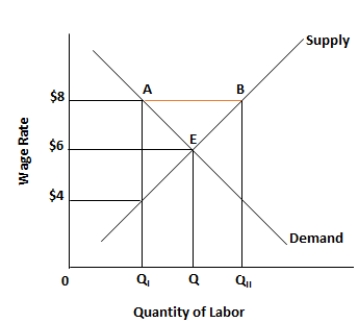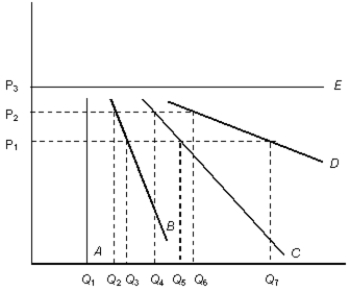A) a 100 percent increase in price would increase the quantity supplied by 75 percent
B) doubling of the price would increase the quantity supplied by 175 percent
C) 50 percent increase in price would increase the quantity supplied by 25 percent
D) 75 percent increase in price would increase the quantity supplied by 100 percent
E) 120 percent increase in price would increase the quantity supplied by 90 percent
Correct Answer

verified
Correct Answer
verified
Multiple Choice
Scenario 5.1 The demand for noodles is given by the following equation: Q = 20 - 4P + 0.2I - 2Px. Assume that P = $8, I = 200, and Px = $10. -Given the above equation, the quantity of noodles demanded at a price of $8 is _____.
A) 8
B) 10
C) 12
D) 4
E) 20
Correct Answer

verified
Correct Answer
verified
Multiple Choice
The table below shows the quantities of automobiles, margarine, and coffee purchased by Ted at different levels of income.Table 6.2
 -If 12 candy bars are demanded at $0.30 each and 4 candy bars are demanded at $0.50 each, what is the elasticity of demand over the price range from $0.30 to $0.50?
-If 12 candy bars are demanded at $0.30 each and 4 candy bars are demanded at $0.50 each, what is the elasticity of demand over the price range from $0.30 to $0.50?
A) 2
B) 1.67
C) 0.5
D) 7.5
E) 0.4
Correct Answer

verified
Correct Answer
verified
Multiple Choice
Figure 5.3. The figure shows the wage rate and the quantity of labor supplied in an unskilled labor market.  -If the price elasticity of demand for a product is equal to 4, a 1 percent increase in price of the product will cause the quantity demanded to _____ by _____ percent.
-If the price elasticity of demand for a product is equal to 4, a 1 percent increase in price of the product will cause the quantity demanded to _____ by _____ percent.
A) increase; 0.25
B) decrease; 0.25
C) increase; 4
D) decrease; 25
E) decrease; 4
Correct Answer

verified
Correct Answer
verified
Multiple Choice
The figure given below shows the demand curves for five products: A, B, C, D, and E.Figure 6.1
 -Refer to Figure 6.1. The demand curve E is most likely to represent the demand for:
-Refer to Figure 6.1. The demand curve E is most likely to represent the demand for:
A) alcohol by an alcoholic.
B) a life-saving drug.
C) holiday travel packages.
D) a particular brand of breakfast cereal.
E) air conditioning during a hot summer.
Correct Answer

verified
Correct Answer
verified
True/False
Scenario 5.1 The demand for noodles is given by the following equation: Q = 20 - 4P + 0.2I - 2Px. Assume that P = $8, I = 200, and Px = $10. -In the long run, the quantity of capital available to a firm is fixed.
Correct Answer

verified
Correct Answer
verified
Multiple Choice
Scenario 5.1 The demand for noodles is given by the following equation: Q = 20 - 4P + 0.2I - 2Px. Assume that P = $8, I = 200, and Px = $10. -Which of the following situations is represented by a nearly horizontal supply curve for a good?
A) Small price changes lead to small changes in quantity demanded of the good.
B) Small price changes lead to small changes in quantity supplied of the good.
C) Producers of the good are not operating efficiently.
D) Producers of the good are not maximizing profit.
E) Small changes in the price of the good lead to large changes in the quantity supplied of the good.
Correct Answer

verified
Correct Answer
verified
Multiple Choice
The table below shows the quantities of automobiles, margarine, and coffee purchased by Ted at different levels of income.Table 6.2
 -Based on the information given in Table 6.2, coffee would be considered:
-Based on the information given in Table 6.2, coffee would be considered:
A) an inferior good.
B) a necessity.
C) a substitute good.
D) a complement good.
E) a luxury good.
Correct Answer

verified
Correct Answer
verified
Multiple Choice
Figure 5.3. The figure shows the wage rate and the quantity of labor supplied in an unskilled labor market.  -If the demand for a product is unit-elastic, a 25 percent increase in its price will result in:
-If the demand for a product is unit-elastic, a 25 percent increase in its price will result in:
A) a 25 percent change in total revenue.
B) no change in quantity demanded.
C) a 1 percent increase in quantity demanded.
D) a 25 percent decrease in quantity demanded.
E) a 100 percent change in quantity demanded.
Correct Answer

verified
Correct Answer
verified
Multiple Choice
Scenario 5.1 The demand for noodles is given by the following equation: Q = 20 - 4P + 0.2I - 2Px. Assume that P = $8, I = 200, and Px = $10. -Acme Tools manufactures anvils, a forging tool. When the price of anvils was increased from $7 to $13, Acme Tools was willing and able to increase production from 1 to 4 units per day. Using the midpoint formula, what is Acme's price elasticity of supply for anvils?
A) 2
B) 1
C) 0.5
D) 4
E) 3.5
Correct Answer

verified
Correct Answer
verified
Multiple Choice
Scenario 5.1 The demand for noodles is given by the following equation: Q = 20 - 4P + 0.2I - 2Px. Assume that P = $8, I = 200, and Px = $10. -Given the above equation, the price elasticity of demand for noodles is _____.
A) 4
B) 0.5
C) 2
D) 2.5
E) 1.6
Correct Answer

verified
Correct Answer
verified
True/False
Scenario 5.1 The demand for noodles is given by the following equation: Q = 20 - 4P + 0.2I - 2Px. Assume that P = $8, I = 200, and Px = $10. -Demand is price-elastic at the top portion of a straight-line downward-sloping demand curve.
Correct Answer

verified
Correct Answer
verified
True/False
Scenario 5.1 The demand for noodles is given by the following equation: Q = 20 - 4P + 0.2I - 2Px. Assume that P = $8, I = 200, and Px = $10. -By measuring the price elasticity of demand in terms of percentage changes, economists are able to compare the way consumers respond to changes in the prices of different products.
Correct Answer

verified
Correct Answer
verified
Showing 121 - 133 of 133
Related Exams